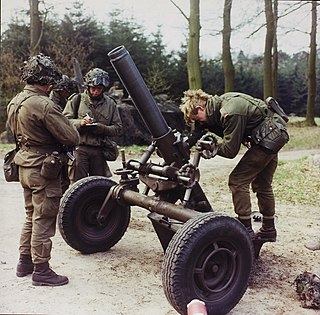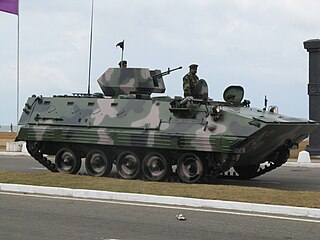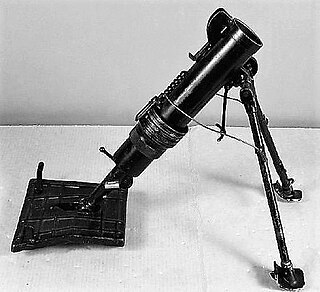Related Research Articles

A mortar is today usually a simple, lightweight, man-portable, muzzle-loaded cannon, consisting of a smooth-bore metal tube fixed to a base plate with a lightweight bipod mount and a sight. Mortars are typically used as indirect fire weapons for close fire support with a variety of ammunition. Historically mortars were heavy siege artillery. Mortars launch explosive shells in high-arching ballistic trajectories.

The M224 60 mm Lightweight Company Mortar System (LWCMS) is a smoothbore, muzzle-loading, high-angle-of-fire mortar used for close-in support of ground troops. It was deployed extensively in the War in Afghanistan by the United States military.

The M252 81 mm medium weight mortar is a British-designed smooth bore, muzzle-loading, high-angle-of-fire weapon used for long-range indirect fire support to light infantry, air assault, and airborne units across the entire front of a battalion zone of influence. In the U.S. Army and U.S. Marine Corps, it is normally deployed in the mortar platoon of an infantry battalion.

In engineering, a foundation is the element of a structure which connects it to the ground or more rarely, water, transferring loads from the structure to the ground. Foundations are generally considered either shallow or deep. Foundation engineering is the application of soil mechanics and rock mechanics in the design of foundation elements of structures.

Soltam Systems is an Israeli defense contractor and kitchen equipment manufacturer located in Yokneam, Israel. The company has been developing and manufacturing advanced artillery systems, mortars, ammunition, peripheral equipment and cooking equipment since 1952. Soltam Systems serves armed and special forces in more than 60 countries as well as the private sector with its kitchen products. Among the company's major customers are the Israel Defense Forces (IDF), the United States Army and NATO countries.

Cave popcorn, or coralloids, are small nodes of calcite, aragonite or gypsum that form on surfaces in caves, especially limestone caves. They are a common type of speleothem.

A counter-battery radar or weapon tracking radar is a radar system that detects artillery projectiles fired by one or more guns, howitzers, mortars or rocket launchers and, from their trajectories, locates the position on the ground of the weapon that fired it. Such radars are a subclass of the wider class of target acquisition radars.

The AA mine discharger was a Japanese anti-aircraft weapon of the Second World War. The device was a simple tube like an infantry mortar of 70 mm (2.8 in) or 81 mm (3.2 in) caliber. Instead of a standard mortar bomb, the projectile was a tube containing seven individual mines, each approximately 11/16ths of an inch in diameter (18 mm) and 3 inches (76 mm) long. Each mine was equipped with its own parachute. When fired, the mortar threw the shell to a range of 3,000 to 4,000 feet and a maximum altitude of approximately 600 m (2,000 ft). The shell ejected the mines at the top of its arc. They would then float down on their parachutes. They were fused to detonate on contact or after a fixed time period, damaging nearby aircraft. The projectile could alternatively be launched using a standard Type 11 70 mm infantry mortar.
Anti-submarine mortars are artillery pieces deployed on ships for the purpose of sinking submarines by a direct hit with a small explosive charge. They are often larger versions of the mortar used by infantry and fire a projectile in relatively the same manner. They were created during World War II as a development of the depth charge and work on the same principle.

The 2R2M is a vehicle-mounted, rifled 120 mm heavy mortar produced by Thales of France. It is derived from the MO-120-RT towed mortar. The 2R2M is in service with 5 nations.

The MO-120 RT or MO-120-RT is a French heavy mortar. The RT in the designator stands for rayé, tracté, which means rifled, towed. The MO-120-RT is currently used by the French Army, and has also been exported to more than 24 foreign countries or in some cases, produced under licence. It is issued to artillery units, where it complements artillery guns and systems; although infantry units operate it in some countries.

The 2S4 Tyulpan is a Soviet 240 mm self-propelled heavy mortar. "2S4" is its GRAU designation. The Tyulpan is the largest mortar system in use today.

The Norinco Type 89 tracked armoured fighting vehicle is a Chinese armoured personnel carrier. It was developed from the earlier export market Type 85 AFV vehicle. It entered service in the late 1990s and was first shown publicly in 1999. There are approximately 1,000 in service. It has the industrial index of WZ534 and although it was mainly developed for the PLA, there is also an export version YW534.

The Type 90 is an armoured fighting vehicle produced by Chinese company Norinco; it is the successor for the Type 85 AFV of which it uses some components. The Type 90 series was developed for export, and consists of at least 10 different types; its industrial index is YW535.

A precision-guided munition (PGM), also called a smart weapon, smart munition, or smart bomb, is a guided munition intended to hit a specific target, to minimize collateral damage and increase lethality against intended targets. During the Persian Gulf War guided munitions accounted for only 9% of weapons fired, but accounted for 75% of all successful hits. Despite guided weapons generally being used on more difficult targets, they were still 35 times more likely to destroy their targets per weapon dropped.
The MAT-120 cargo bomb is a Spanish-produced cluster munition, fired from a 120mm calibre mortar produced by Instalaza SA. The main body of the round holds dual-purpose anti-tank/anti-personnel submunitions. The MAT-120 submunitions are unique in that to prevent the dangers of unexploded duds, there is a double redundant feature the manufacturer refers to as self-destruction and self-sterilization. This prevents unexploded MAT-120 submunitions from lying around becoming de facto landmines, dangerous to both combatants and non-combatants.
The Battle of Ap Gu occurred during 31 March and 1 April 1967 during Operation Junction City, a search and destroy mission by American military forces in Tay Ninh Province of South Vietnam, to the west of the capital Saigon. The battle near the border with Cambodia left 609 Viet Cong (VC) killed according to US sources, with 5 captured, and over 50 weapons of all types recovered, while the Americans lost 17 killed and 102 wounded.

The Soviet 240 mm mortar M240 is a 240 millimeter breech loading smoothbore heavy mortar that fires a 130 kilogram projectile. It entered service in 1953.

The Lance Grenades de 50 mm modèle 37 was a French light infantry mortar designed and produced shortly before the Second World War.